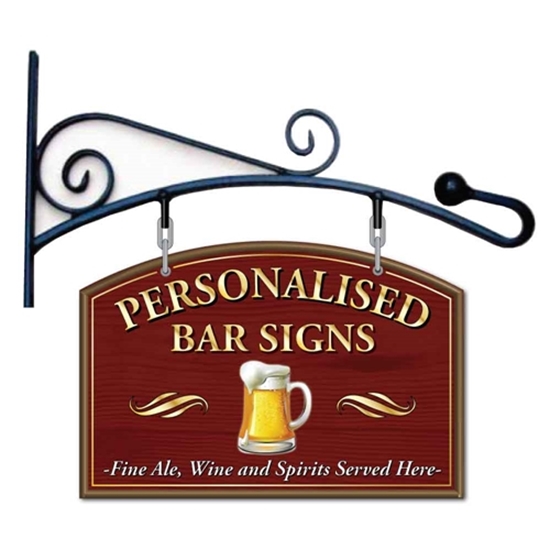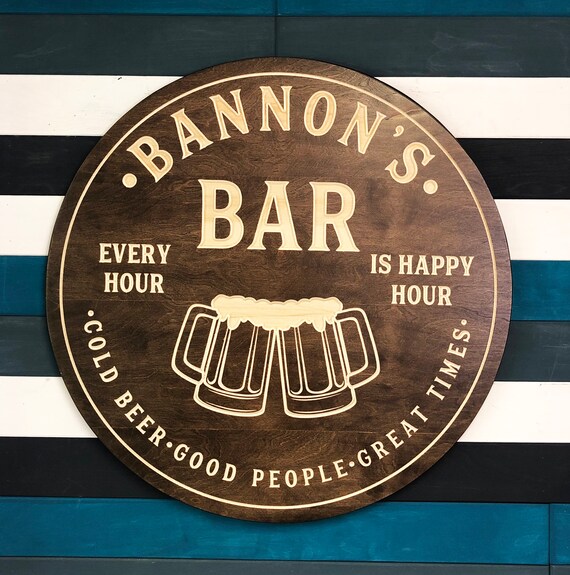Great Advice To Deciding On Personalised Pub Signs
Great Advice To Deciding On Personalised Pub Signs
Blog Article
What Is The Purpose Of Different Bar Signposts?
The reason for bar signs can vary significantly. Bar signs are used for many different purposes. Branding
Purpose : To reinforce the bar's reputation and identity.
Often features the bar logo, name and signature colours. It's designed to be an imposing feature that is representative of the general theme and atmosphere of the establishment.
For example, neon signs with a bar's logo or custom metal signs that feature the name of the bar.
2. Information
Use: Provide vital information to patrons about the bar.
Features: Clear and easy-to read text that explains important information, like the hours of operation, Wi Fi passwords for the house and rules of conduct or bathroom locations.
Examples: Signs at the entrance to indicate the hours of operation and signs that point towards restrooms.
3. Design
Purposes: To enhance aesthetic appeal and enhance the ambience of the bar.
Highlights: They are typically artistic or thematic and add to the aesthetics of the entire bar. It is not required to include any text or specific information.
Examples: Vintage ads for beer, signs that have a humor or a humorous tone or themed artwork.
4. Promotional Materials
The purpose of this is to promote products, events or specials.
Features: Design with attractive images that highlight special deals or upcoming events. Some elements may be temporary or changeable.
Examples: chalkboards that list daily specials, banners promoting special deals during happy hour or posters for an upcoming event.
5. Directional
Use for directing patrons to the right bar.
Features: Clearly marked arrows and instructions to help the customer navigate through the bar, e.g., finding restrooms, exits or other sections.
Examples: Directional signs to various seating locations.
6. Regulatory/Compliance
The purpose of this program is to comply with legal requirements and ensure the safety of our customers.
Specifications: Signs necessary to fulfill legal obligations such as smoking zones and occupancy limits, as well as emergency exits.
For example, "No Smoking", "Occupancy Limit" and "Emergency Exit" signs.
7. Interactive
The goal is to engage customers and provide an interactive experience.
Features: Elements that encourage patron involvement, such as writing-on surfaces and digital interactions.
Examples: Chalkboards with messages to customers, signs with QR codes linking to digital menus, or social media.
8. Thematic
Goal: To develop a specific theme or atmosphere.
Themes: Signs that are in line with the bar's theme and contribute to the overall ambience.
Examples: Pirate themed signs in the nautical bar, rustic wood signs in the country bar.
9. Menu
Scope: To display the bar's menu of food.
The list of food and drinks is usually listed in a clear manner together with the costs. Can be either fixed or modifyable.
Examples include digital screens that show food items that rotate, or drinks lists that are mounted on the wall.
Each bar sign is created to serve a particular purpose. The design of each sign is based on its role in the bar. Understanding these differences will help bar owners decide on and put up signs to satisfy their needs and enhance the experience of their patrons. View the top I thought about this for hanging bar sign for more recommendations including design your own bar sign, bar wall signs, signs for the bar, personalised home bar signs, bar pub signs, outdoor home bar signs, cocktail bar sign, to the pub sign, personalised pub signs for sale, staying inn sign and more.
How Are Bar Signs Mounted And Installed Different?
There are different ways of mounting and installing bar signs based on their weight, size and the location. This article will offer a detailed look at the different mounting and installation options for bar sign. Wall-Mounted Bar Signs
Directly fixed to walls.
Methods:
Anchors and screws are used to secure heavier signs (metal and wood).
Adhesive Strips are able to be used to create lightweight signs (foam boards and acrylics) and temporary installations.
Brackets are used to make signs more visible by allowing them protruding out from the wall.
Uses: Indoor decor, menu boards, directional signs.
Benefits: Safe and flexible display.
Negatives: May be damaging to walls, hard to move.
2. Hanging Signs
Characteristics Suspended from ceilings or overhangs.
Methods:
Chains are durable and adjustable great for signs with heavy weights.
Cables: Slimmer appearance. Often used for modern designs.
Rods: Provide a rigid support structure.
Uses: Ceiling decor, directional signs, overhead promotional signs.
The vertical space is highly visible and the decorative options are endless.
Disadvantages
3. Signs for Freestanding Places
The product's characteristics are: The stand is not attached to anything.
Methods:
A-Frames are portable and foldable. Most often, they are used to advertise on sidewalks.
Pedestal Stands: Stable base, ideal for indoor use.
Post and Panel Common for larger, permanent signs.
Uses: Outdoor advertising, indoor directional signs, promotional displays.
Advantages: Lightweight, portable and simple to move.
It is often bulky and requires the use of a floor.
4. Window Signs
The characteristics of this device are that it is attached directly to windows directly.
Methods:
Suction cups are simple to put in and remove. They're suitable for signs that are lighter.
Adhesive Glass can be directly applied to the surface of the glass. Ideal for decals, graphics, as well as other graphics.
Static Cling: Permanent, non-permanent and simple to apply or remove.
Uses : Promotional messages and branding.
Benefits: Maximizes windows, and is highly visible from the outside.
Limitations in window size and sunlight can affect the performance.
5. Signs with Edge-Lit or Backlit Lighting
The sign's characteristics include lighting within the sign structure.
Methods:
Wall Mounting with Electrical Connections. This requires electrical connections and secure connection.
Suspended With Power Cables Suspended with Power Cables: Combines hanging and integrated lighting.
Uses: Branding through high visibility, menu boards and decorative elements.
Advantages: Improved visibility, attractive illumination.
Negatives: Requires electrical wiring, more complex installation.
6. Portable and Temporary Signs
Specifications Designed to facilitate simple and quick set-up.
Methods:
Pop-Up stand: light and compact.
Banner Stands: Roll-up or retractable designs.
Uses: Promotions and events Decoration for seasonal events.
Benefits: Quick and easy installation, and transportable.
Disadvantages : less durable and could not last as long.
7. Magnetic Signs
Magnetic force is used to attach.
Methods:
Magnetic Strips : The magnetic strips are affixed to signs.
Magnetic Boards. Signs attached to metallic surfaces.
Uses for: Temporary notices, menu boards that can be altered.
Benefits The benefits are that no permanent fixtures are needed, and the item is easy to replace.
Advantages only available on magnetic surfaces. Can be less secure.
8. Projection Signs
Use light to project a image or text.
Methods:
Mounted Projectors: Securely mounted on ceilings or walls.
Portable projectors are placed on a stand or a surface.
Uses: Events, promotions Dynamic displays.
Benefits The content can be modified easily, and there is no need for physical signs.
Negatives
Considerations for mounting and installation
Weight and Size
Heavy Signs : Need more robust mounting methods like anchors and screws.
Light Signs: Use simple methods such as suction cups or adhesive strips.
Durability
Permanent Signs: Use mounting methods that are more robust and safe.
Temporary signage: Select methods that allow you to move and relocate the sign.
Location
Indoor: Greater flexibility with materials and methods with less concern about weather resistance.
Outdoor: requires weather-resistant materials and a secure mounting order to withstand elements.
Aesthetics
Concealed mounting: This option gives a more professional appearance by concealing the hardware.
Decor Hardware: Enhances look of the sign.
Accessibility
Easy access for changes Great for signs that need to be updated frequently like menu boards.
Security: Signs must not be easily taken or altered with.
Bar owners must consider these factors to choose the best mounting and installation technique that is suitable for their needs. This will ensure that their signs are easily visible, safe and meet their aesthetic and functional requirements. Have a look at the recommended bar signs for home bar blog for more advice including home bar pub signs, garden bar sign personalised, bar signs, garden pub signs, make a bar sign, pub signs made, personalised garden pub sign, personalised beer sign, bar sign hanging, personalised garden pub sign and more.
What Are The Differences Between Bar Signs And Interactive Signs?
There are different kinds of interactivity that can be applied to bar signs to improve customer engagement and experience. Bar signs can be classified based on the degree of interaction. Static Signs
Static signs are a traditional method to communicate information. They don't have any interactive components.
Common Types: Printing posters, painted murals, or the standard neon signs.
2. Digital Displays
Digital Signs permit multimedia content as well as real-time animations.
Displays with touchscreens offer interactive content such as promotional or games.
Benefits include: Draw attention to information that is dynamic while promoting patron engagement.
3. QR Codes
Interactive Links QR codes on signs can lead to menus and social media profiles and promotions.
The benefits of this app are: Easy access for additional information and offers.
4. LED Screens
Dynamic Messaging: LED screens are able to display scrolling text, animations, or video content.
Touch-enabled LCD screens allow users to interact with content. For example they can choose the menu options or play games.
Benefits: Grab attention, convey information effectively, and create immersive experiences.
5. Projection Mapping
Immersive Experiences Projection mapping alters the surfaces providing interactive visuals and the ability to tell stories.
Interactivity: Visitors can interact with projected elements, like virtual games, interactive ones or even.
Benefits: Increase the ambience and social interaction while creating memorable experiences.
6. Augmented Reality
Enhanced Reality: AR overlays digital content onto the physical environment offering interactive experiences.
The sign that is AR-enabled allows users to interact with digital elements such as a cocktail recipe, or playing virtual games.
Benefits : Create a memorable experience, connect with your customers and distinguish yourself from competitors.
7. Motion Sensors
Responsive Signage: Motion sensors detect movement and trigger interactivity in signs.
Signs can be interactive and respond to the movement of the patrons through displaying animated content, altering its contents, or displaying customized messages.
Benefits Enhance engagement, design immersive settings, and surprise patrons.
8. Social Media Integration
Interactive Online: Signs may feature hashtags or handles for social media to encourage people to interact on the internet.
User-generated Content: Inspire patrons to post photos of the signage on social media platforms to increase the reach of the bar and its visibility.
Benefits : Increase community engagement, increase brand recognition, create user-generated material.
9. Interactive Lighting
Dynamic Effects: Interactive LED signs or neon signs can react to touch, sound or motion.
Signs that interact alter their color, brightness and patterns according to patron interaction or environmental clues.
Benefits: Enhance the ambiance and create immersive spaces.
10. Gamification
Interactive Games: Signs include interactive games or challenges that entertain patrons and encourage participation.
Rewards: Offer rewards like freebies or discounts in exchange for winning games or fulfilling challenges.
Benefits: Increase dwell time increase social interaction and encourage frequent visits.
Bar owners who include interactive elements in their signage will create an engaging experience that will capture customers' attention, enhance brand awareness and distinguish their business from a highly competitive market. Have a look at the best this hyperlink about personalised pub signs for site tips including home pub signs, personalised garden pub sign, personalised hanging pub signs, personalised home pub sign, pub signs made, the staying inn sign, signs for the bar, bar hanging sign, make a pub sign, hanging pub signs for garden and more.